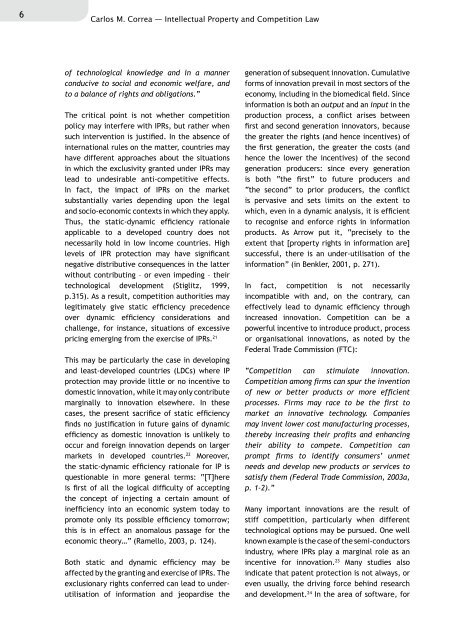Intellectual Property and Competition Law - IPRsonline.org
Intellectual Property and Competition Law - IPRsonline.org
Intellectual Property and Competition Law - IPRsonline.org
You also want an ePaper? Increase the reach of your titles
YUMPU automatically turns print PDFs into web optimized ePapers that Google loves.
Carlos M. Correa — <strong>Intellectual</strong> <strong>Property</strong> <strong>and</strong> <strong>Competition</strong> <strong>Law</strong>of technological knowledge <strong>and</strong> in a mannerconducive to social <strong>and</strong> economic welfare, <strong>and</strong>to a balance of rights <strong>and</strong> obligations.”The critical point is not whether competitionpolicy may interfere with IPRs, but rather whensuch intervention is justified. In the absence ofinternational rules on the matter, countries mayhave different approaches about the situationsin which the exclusivity granted under IPRs maylead to undesirable anti-competitive effects.In fact, the impact of IPRs on the marketsubstantially varies depending upon the legal<strong>and</strong> socio-economic contexts in which they apply.Thus, the static-dynamic efficiency rationaleapplicable to a developed country does notnecessarily hold in low income countries. Highlevels of IPR protection may have significantnegative distributive consequences in the latterwithout contributing – or even impeding – theirtechnological development (Stiglitz, 1999,p.315). As a result, competition authorities maylegitimately give static efficiency precedenceover dynamic efficiency considerations <strong>and</strong>challenge, for instance, situations of excessivepricing emerging from the exercise of IPRs. 21This may be particularly the case in developing<strong>and</strong> least-developed countries (LDCs) where IPprotection may provide little or no incentive todomestic innovation, while it may only contributemarginally to innovation elsewhere. In thesecases, the present sacrifice of static efficiencyfinds no justification in future gains of dynamicefficiency as domestic innovation is unlikely tooccur <strong>and</strong> foreign innovation depends on largermarkets in developed countries. 22 Moreover,the static-dynamic efficiency rationale for IP isquestionable in more general terms: “[T]hereis first of all the logical difficulty of acceptingthe concept of injecting a certain amount ofinefficiency into an economic system today topromote only its possible efficiency tomorrow;this is in effect an anomalous passage for theeconomic theory…” (Ramello, 2003, p. 124).Both static <strong>and</strong> dynamic efficiency may beaffected by the granting <strong>and</strong> exercise of IPRs. Theexclusionary rights conferred can lead to underutilisationof information <strong>and</strong> jeopardise thegeneration of subsequent innovation. Cumulativeforms of innovation prevail in most sectors of theeconomy, including in the biomedical field. Sinceinformation is both an output <strong>and</strong> an input in theproduction process, a conflict arises betweenfirst <strong>and</strong> second generation innovators, becausethe greater the rights (<strong>and</strong> hence incentives) ofthe first generation, the greater the costs (<strong>and</strong>hence the lower the incentives) of the secondgeneration producers: since every generationis both “the first” to future producers <strong>and</strong>“the second” to prior producers, the conflictis pervasive <strong>and</strong> sets limits on the extent towhich, even in a dynamic analysis, it is efficientto recognise <strong>and</strong> enforce rights in informationproducts. As Arrow put it, “precisely to theextent that [property rights in information are]successful, there is an under-utilisation of theinformation” (in Benkler, 2001, p. 271).In fact, competition is not necessarilyincompatible with <strong>and</strong>, on the contrary, caneffectively lead to dynamic efficiency throughincreased innovation. <strong>Competition</strong> can be apowerful incentive to introduce product, processor <strong>org</strong>anisational innovations, as noted by theFederal Trade Commission (FTC):“<strong>Competition</strong> can stimulate innovation.<strong>Competition</strong> among firms can spur the inventionof new or better products or more efficientprocesses. Firms may race to be the first tomarket an innovative technology. Companiesmay invent lower cost manufacturing processes,thereby increasing their profits <strong>and</strong> enhancingtheir ability to compete. <strong>Competition</strong> canprompt firms to identify consumers’ unmetneeds <strong>and</strong> develop new products or services tosatisfy them (Federal Trade Commission, 2003a,p. 1-2).”Many important innovations are the result ofstiff competition, particularly when differenttechnological options may be pursued. One wellknown example is the case of the semi-conductorsindustry, where IPRs play a marginal role as anincentive for innovation. 23 Many studies alsoindicate that patent protection is not always, oreven usually, the driving force behind research<strong>and</strong> development. 24 In the area of software, for









